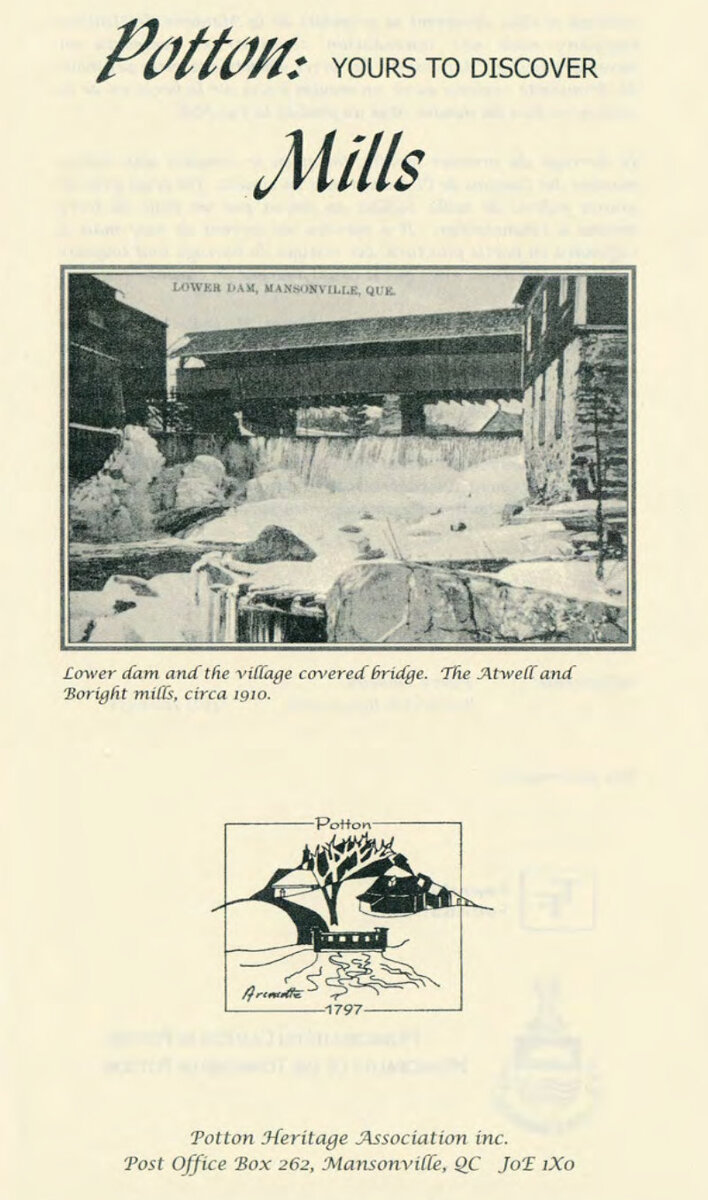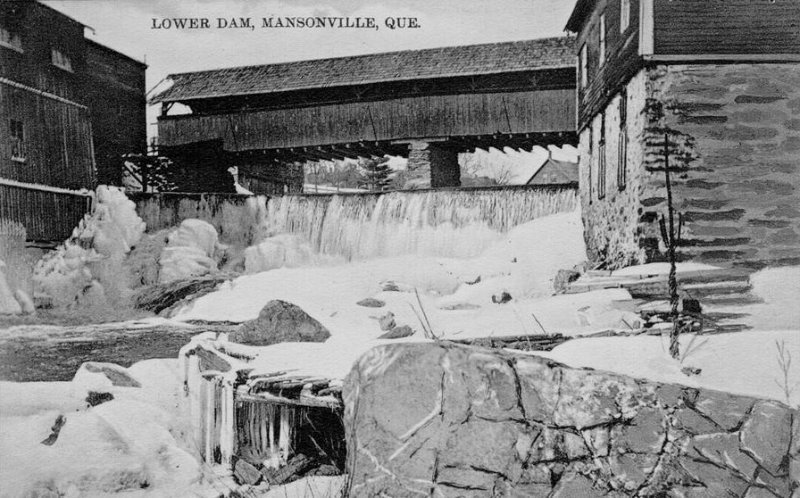The Water Mills of Potton
After arriving in Potton Township, the first settlers quickly looked for a good source of fast flowing water where they could build theirs mills, which were of vital importance to the growth and prosperity of the new communities. Several mills were built in various parts of the Township.
Around 1796 Col. Henrick Ruiter, a Loyalist who fled New York State after the Revolutionary war, settled in West Potton (Dunkin) on the brook which today bears his name and built the first saw and grist mills in the Township.
At the head of Ruiter Brook, Sheldon Boright is credited with building, in 1911, a stone dam measuring 175 meters in length with a cement spillway. A earth bank laid the whole length on the upstream side to seal the dam. This created Fullerton Pond and a saw mill was built just below the dam.
Ruiter Brook was used to float logs downstream towards the Missisquoi River on their way to Richford, VT.
Huge log jams would result and, it is said, the late Peter Aiken from Dunkin was an expert in untangling them.
Two other mills were built later on the Vale Perkins Brook, one of them with very intriguing foundations built with stones weighing up to four metric tons still lying intact in the brook.
Its origin has never been explained, but an archaeological dig revealed the presence of charcoal dating to around 500 years ago. Who built these foundations, is a mystery!
Because of the swift current and rapids of the Missisquoi River in Mansonville, it was here that in 1803 Messrs. Chandler and Lewis built the village’s fist mill, at the foot of Mill St.
Chandler became the sole owner, then sold to Robert Manson whose name appears on the 1796 census of the Township and after whom the village was named.
Manson also built a mill on the east side of the river just below the bridge and, in 1829, his son James built a carding mill used in making cloth, and a tanning mill for processing hides.
The Walling map of 1864 shows five mills in the village: a carding mill, two saw mills, a tanning mill and a grist mill for grinding grain.
A second dam, built just below what was then a covered bridge, provided power for two more mills located on either side of the river, which were owned by Messrs. Henry Boright and Atwell.
The covered bridge of the time was replaced by a modern one around 1927.
In 1903, Charles Brouillette installed a small hydroelectric power plant on an island in the Missisquoi river between the mill site and the bridge, which supplied enough electricity to light a part of the village just before Midnight Mass, on Christmas Eve. It was later owned by the Mansonville Utilities Company.
The devastating flood of November 1927 swept away the electric power plant, leaving Mansonville without power for several months.
Brouillette also operated a saw mill on the east side of the river, across from the mill at the bottom of Mill Street.
The dam of the first local mill was built of large stones and had an earth bank raised behind to prevent water from seeping through. It survived the 1927 catastrophic flood, but part of it later collapsed.
The remains of the stone dam can still be seen today along whith the cement water channel for the water wheel that operated the mill’s machinery.
The last owners who later operated the mill include a Mr. Arthur Leduc, who lived on Pine Steet and ran a woodworking factory. J.A. Raquepas, from Eastman, used it as a grist mill and then, H.W. Sullivan sold animal feed before the Coop took over and later sold the place to Pierre Giroux, in 1990.
A fire levelled this heritage building during the summer of 2000 and the Municipality of Potton Township purchased the site and plans to make it a park.
Production team
Text: Peter Downman and Gérard Leduc
Graphic design: Pierre Nadeau | Estrie-Art Infographie
Oginal edition: 2003
Web edition: Serge Normand, 2024
Web edition revision: Jacqueline Robitaille, 2025



